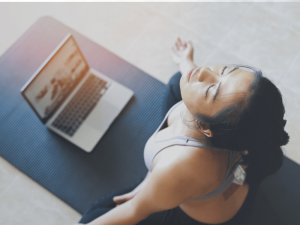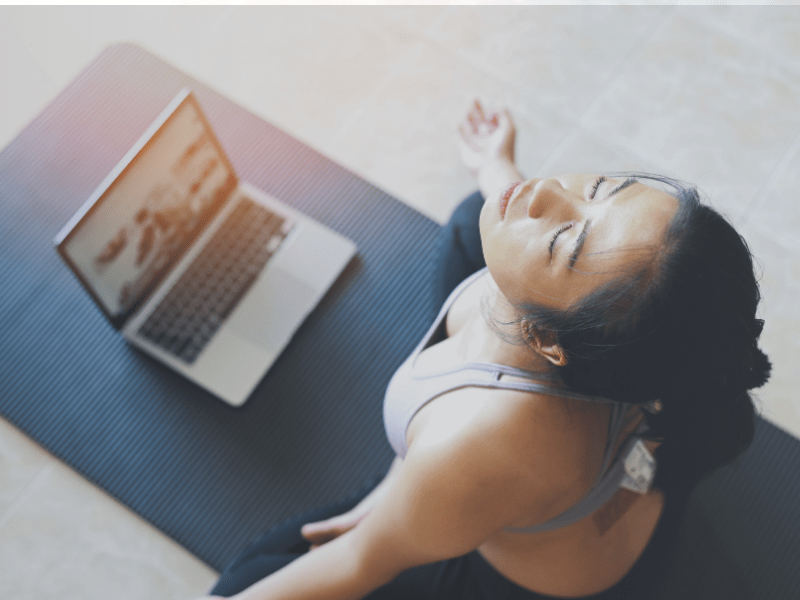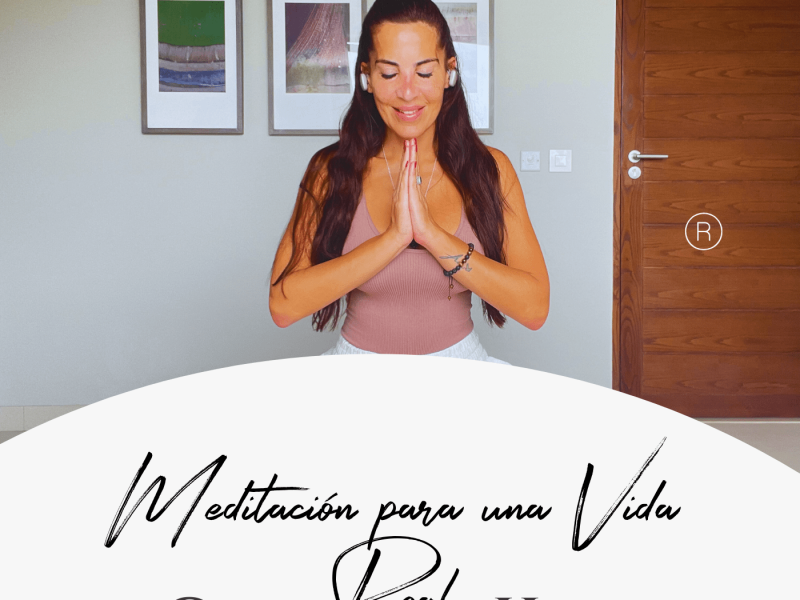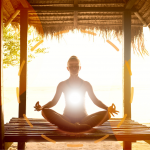This post shows you 6 simple ways to use daily meditation to calm your mind
WHAT IS MEDITATION?
Meditation refers to a type of mental exercise and reflection that people do about something in particular, whether spiritual or physical. It is an activity that can be done by anyone.
The word meditation originates from the Latin meditatĭo, which indicates the action of meditating.
Meditation encourages putting concentration and relaxation into practice, in this way people will be able to analyze and obtain a clearer vision of everything they experience and that may be generating some uncertainty or discontent internally.
The main objective of meditating is to reach a point of concentration and mental relaxation in order to feel inner peace, which is achieved through perseverance; Its benefits can be enjoyed as the technique advances.
ELEMENTS OF MEDITATION
Different types of meditation can include different elements to help you meditate. These may vary depending on who guides you or who teaches the class. Some of the most common elements in meditation include:
- Concentrate attention. Concentrating attention is generally one of the most important elements of meditation.
It is what helps free your mind from the many distractions that cause stress and worry. You can focus your attention on things like a specific object, an image, a mantra, or even your breath.
- Relaxed breathing. This technique involves deep, even breathing, using the diaphragm muscle to expand the lungs. The purpose is to slow your breathing, receive more oxygen, and reduce the use of the muscles in your shoulders, neck, and upper chest when breathing, to breathe more efficiently.
A quiet place. If you are a beginner, practicing meditation will be easier if you are in a quiet place with few distractions, including no television, radio, or cell phone. As you become more experienced with meditation, you may be able to meditate anywhere, especially in situations of a lot of stress when you would benefit most from meditating, such as in a traffic jam, in a stressful work meeting, or waiting in a long line at the supermarket.
A comfortable position. You can practice meditation sitting, lying down, walking, in other positions, or during activities. Just try to be comfortable so you can get the most out of your meditation. Try to maintain good posture during meditation.
Open attitude. Allow thoughts to pass through your mind without judging them.
6 DAILY WAYS TO PRACTICE MEDITATION
Don’t let the idea of meditating “properly” increase your stress. If you wish, you can attend special meditation centers or group classes led by trained instructors. However, you can also easily practice meditation on your own. Or you can use apps.
Additionally, you can make your meditation as formal or informal as you want, depending on what suits your lifestyle and personal situation. Some people make meditation part of their daily routine. For example, you can start and end your day with an hour of meditation. But you only need a few minutes of quality time to meditate.
These 6 ways to practice meditation are focused on integrating meditation into the person’s daily life:
BREATH DEEPLY.
This technique is good for beginners, since breathing is a natural function.
Direct all your attention to your breathing. Focus on what you feel and hear as you breathe in and out through your nose. Breathe deeply and slowly. When you get distracted, gently return your attention to your breathing.
WATCH YOUR BODY
When using this technique, direct your attention to different parts of the body. Pay attention to bodily sensations, whether pain, tension, heat, or relaxation.
Combine the technique of observing your body with breathing exercises and imagine that you inhale and exhale heat or relaxation to and from different parts of your body.
REPEAT A MANTRA
You can create your own mantra, whether religious or not. Some examples of religious mantras include the Jesus prayer in the Christian tradition, the sacred name of God in Judaism, or the om mantra of Hinduism, Buddhism, and other Eastern religions.
WALK AND MEDITATE.
Meditating while walking is an efficient and healthy way to relax. You can use this technique wherever you walk, such as in a quiet forest, on a city sidewalk, or at the mall.
When using this method, slow down your walking speed to focus on each movement of your legs or feet. Don’t focus on a specific destination. Focus on your legs or feet and repeat action verbs in your mind, such as “I lift,” “I move,” and “I put down” as you lift your foot, move your leg forward, and lower your foot to the ground. Direct your attention to what you see, hear and smell around you.
READ AND REFLECT
Many people say they benefit from reading poems or sacred texts, and taking a moment to silently reflect on their meanings.
You can also listen to sacred music, spoken words, or any music that you find relaxing or inspiring. You could write your reflections in a journal and talk about them with a friend or spiritual leader.
FOCUS ON YOUR LOVE AND KINDNESS
In this type of meditation, think of others with feelings of love, compassion, and kindness. This can help you feel more connected to others.
How to improve your ability to meditate

Don’t judge your ability to meditate, as this can increase your stress. Meditation takes practice.
Remember, for example, that it is common for your mind to wander while you meditate, no matter how long you have been practicing meditation. If you are meditating to calm your mind and your attention wanders, slowly return to the object, sensation, or movement you are focusing on.
Experiment, and you’ll probably discover what types of meditation are best for you and what you enjoy. Adapt the meditation to what you need at that moment. Remember, there is no right or wrong way to meditate.
DO YOU NEED TO INTEGRATE MEDITATION AS A ROUTINE AND YOU DON’T KNOW HOW TO START?
My Meditation for a Real Life program is focused on helping people like you who need the benefits of meditation to transform the daily chaos they live.
The beginner level of the program guarantees you healthy meditation habits from scratch. To do this, create custom progressive meditations that will help you enhance your strengths and balance your weaknesses, create new healthy mental patterns to combat stress and make you aware of your goals and life direction.
All this accompanied by a personalized follow-up for 30 days, where I will show you how your mind was the key to the life change you expected.
Read more about Meditation for a Real Life.
This post shows you 6 simple ways to use daily meditation to calm your mind
WHAT IS MEDITATION?
Meditation refers to a type of mental exercise and reflection that people do about something in particular, whether spiritual or physical. It is an activity that can be done by anyone.
The word meditation originates from the Latin meditatĭo, which indicates the action of meditating.
Meditation encourages putting concentration and relaxation into practice, in this way people will be able to analyze and obtain a clearer vision of everything they experience and that may be generating some uncertainty or discontent internally.
The main objective of meditating is to reach a point of concentration and mental relaxation in order to feel inner peace, which is achieved through perseverance; Its benefits can be enjoyed as the technique advances.
ELEMENTS OF MEDITATION
Different types of meditation can include different elements to help you meditate. These may vary depending on who guides you or who teaches the class. Some of the most common elements in meditation include:
- Concentrate attention. Concentrating attention is generally one of the most important elements of meditation.
It is what helps free your mind from the many distractions that cause stress and worry. You can focus your attention on things like a specific object, an image, a mantra, or even your breath.
- Relaxed breathing. This technique involves deep, even breathing, using the diaphragm muscle to expand the lungs. The purpose is to slow your breathing, receive more oxygen, and reduce the use of the muscles in your shoulders, neck, and upper chest when breathing, to breathe more efficiently.
A quiet place. If you are a beginner, practicing meditation will be easier if you are in a quiet place with few distractions, including no television, radio, or cell phone. As you become more experienced with meditation, you may be able to meditate anywhere, especially in situations of a lot of stress when you would benefit most from meditating, such as in a traffic jam, in a stressful work meeting, or waiting in a long line at the supermarket.
A comfortable position. You can practice meditation sitting, lying down, walking, in other positions, or during activities. Just try to be comfortable so you can get the most out of your meditation. Try to maintain good posture during meditation.
Open attitude. Allow thoughts to pass through your mind without judging them.
6 DAILY WAYS TO PRACTICE MEDITATION
Don’t let the idea of meditating “properly” increase your stress. If you wish, you can attend special meditation centers or group classes led by trained instructors. However, you can also easily practice meditation on your own. Or you can use apps.
Additionally, you can make your meditation as formal or informal as you want, depending on what suits your lifestyle and personal situation. Some people make meditation part of their daily routine. For example, you can start and end your day with an hour of meditation. But you only need a few minutes of quality time to meditate.
These 6 ways to practice meditation are focused on integrating meditation into the person’s daily life:
BREATH DEEPLY.
This technique is good for beginners, since breathing is a natural function.
Direct all your attention to your breathing. Focus on what you feel and hear as you breathe in and out through your nose. Breathe deeply and slowly. When you get distracted, gently return your attention to your breathing.
WATCH YOUR BODY
When using this technique, direct your attention to different parts of the body. Pay attention to bodily sensations, whether pain, tension, heat, or relaxation.
Combine the technique of observing your body with breathing exercises and imagine that you inhale and exhale heat or relaxation to and from different parts of your body.
REPEAT A MANTRA
You can create your own mantra, whether religious or not. Some examples of religious mantras include the Jesus prayer in the Christian tradition, the sacred name of God in Judaism, or the om mantra of Hinduism, Buddhism, and other Eastern religions.
WALK AND MEDITATE.
Meditating while walking is an efficient and healthy way to relax. You can use this technique wherever you walk, such as in a quiet forest, on a city sidewalk, or at the mall.
When using this method, slow down your walking speed to focus on each movement of your legs or feet. Don’t focus on a specific destination. Focus on your legs or feet and repeat action verbs in your mind, such as “I lift,” “I move,” and “I put down” as you lift your foot, move your leg forward, and lower your foot to the ground. Direct your attention to what you see, hear and smell around you.
READ AND REFLECT
Many people say they benefit from reading poems or sacred texts, and taking a moment to silently reflect on their meanings.
You can also listen to sacred music, spoken words, or any music that you find relaxing or inspiring. You could write your reflections in a journal and talk about them with a friend or spiritual leader.
FOCUS ON YOUR LOVE AND KINDNESS
In this type of meditation, think of others with feelings of love, compassion, and kindness. This can help you feel more connected to others.
How to improve your ability to meditate



Don’t judge your ability to meditate, as this can increase your stress. Meditation takes practice.
Remember, for example, that it is common for your mind to wander while you meditate, no matter how long you have been practicing meditation. If you are meditating to calm your mind and your attention wanders, slowly return to the object, sensation, or movement you are focusing on.
Experiment, and you’ll probably discover what types of meditation are best for you and what you enjoy. Adapt the meditation to what you need at that moment. Remember, there is no right or wrong way to meditate.
DO YOU NEED TO INTEGRATE MEDITATION AS A ROUTINE AND YOU DON’T KNOW HOW TO START?
My Meditation for a Real Life program is focused on helping people like you who need the benefits of meditation to transform the daily chaos they live.
The beginner level of the program guarantees you healthy meditation habits from scratch. To do this, create custom progressive meditations that will help you enhance your strengths and balance your weaknesses, create new healthy mental patterns to combat stress and make you aware of your goals and life direction.
All this accompanied by a personalized follow-up for 30 days, where I will show you how your mind was the key to the life change you expected.
Read more about Meditation for a Real Life.






